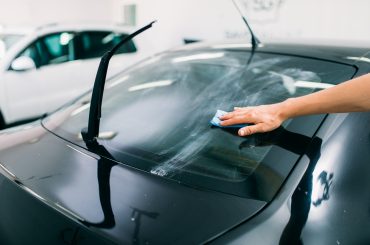If you are wondering what the difference is between window tint and privacy glass, this article is for you. The main difference between the normal tinted glass and privacy glass is that the tinted glasses have a layer of film applied to them, while privacy glass is made by dying the glass itself, to make it look darker.
Read on, and you will learn everything about the differences, benefits, and all other concerns related to privacy glass car windows. If you already have normal car windows and would still like to try out this new variety, a special option is described for you at the end of this article.
Table of Contents
What is Privacy Glass on a Car?
As the name states, the privacy glass in cars creates more privacy by creating a darker effect on the window glass. Very little light would be allowed to pass through the glass. Most manufacturers create privacy glass of Visible Light Transmission factor between 22% and 28%. Hence, these glasses are less transparent than other glasses. These are usually installed by the car factory themselves during the manufacturing of the car. The privacy glasses can also be installed by qualified professionals who undertake contracts on privacy glasses.
It is a common practice to install privacy glass on the back windows for privacy. They are not installed on the two front windows as safety precautions to allow proper vision, especially at night. These are also used on the upper region of the window glass for protection from the sun by reducing the glare on the driver.
Advantages of privacy glass
- Privacy glass car windows last longer in the same quality as tinted windows. This is because the films would easily be scratched and worn off, while it does not happen so in privacy glass. Therefore, privacy glasses have the advantage of not wanting to renew the tint like in the tint films.
- In tinted windows, the films would get detached from one another and would get air bubbles trapped in between these films and glass. It would create the ‘Bubble Effect’ and causes visual obstructions. This does not occur in privacy glass.
- The problems of damaging the film might occur during the installation of tint films on the car window. But such problems do not occur in privacy glass car windows, as they are directly made by manufacturers by shading the glass in the factory.
- The quality of tinted window films might vary depending on the type of film and the number of films used. There may be different levels of darkness created due to this. But in privacy glass, there are standard qualities and darkness levels for the glass.
What Privacy Glass Cannot Do
There are some factors that other window tints can do depending on the type of film, but privacy glass cannot necessarily perform. To find details about other types of tint, refer to our article on Types of Window Tint.
- Advanced tinted glasses such as ceramic tints can block up to 99% of harmful UVA and UVB radiation. The privacy glasses won’t be that efficient.
- There are certain types of tints that reflect off the sun’s rays and reduce the glare. This improves eye comfort while driving. Factory-made privacy glasses do not provide this support.
- Heat is generated due to the trapping of IR radiation within the vehicle. Since most of the tinted car windows are able to reflect back IR rays, the internal heat generation is minimized. But, privacy glasses are unable to provide any heat blocking than transparent automotive glasses.
- Even if a car window is broken, most films of tint help hold the pieces together, which creates a shatter-free nature on the window. But since privacy glass car windows do not have any layer of film, they are unable to reduce the shattering of glass.
The Difference between Privacy Glass and Automotive Glass
The automotive glass is made of tempered glass, through a process of extreme heat and rapid cooling. This makes the glass extremely strong with respect to normal glass. When considering the windshield, it is made up of two layers of tempered glass with a layer of polyvinyl placed in between them. This creates a shatter-resistant effect on the windshield. The privacy glass is created by infusing the tempered glass with a special pigment or dye that darkens the glass. Except for this difference in darkness, the auto window and the privacy glass would have similar physical attributes.
The Option of Having No Privacy Glass
As the name implies, privacy glasses are installed mainly for the securing of privacy. They do not provide any added functions of protection against harmful radiation. Therefore, this might most likely look like an illusion of the manufacturing system. Some people are looking for a way to have added protection that is not provided by these privacy glasses. It is recommended to have a car window tint of proper protection installed, even if your vehicle already has privacy glass. If you need more details on how to install a window tint to your vehicle, you can read more on our article about How to Tint Car Windows.
Installing Privacy Glass After Purchase
Privacy glass is usually made and fitted on the windows during the process of manufacturing. If you need to get privacy glass after the purchase of your vehicle, then you would need to make a special order to the manufacturer. This might be very expensive as the glass needs to be customized for the type and size of your car windows. Installation of these would also require an additional cost of labor. Therefore, a less expensive option is available. It is known as the Privacy Tint application and is discussed below.
What is Privacy Tint?
Privacy tint is a new form of tinting option that matches the color of the privacy glass. It is used as an option for people who are willing to try this option but do not possess factory-manufactured privacy glass. Privacy tint is also a good option for anyone who has privacy glass on the rear windows and needs the same shade on the front windows. But still, there might be concerns about legal restrictions on this. You can find more details about legal limitations by referring to our article on Car Window Tinting Shades Chart.







